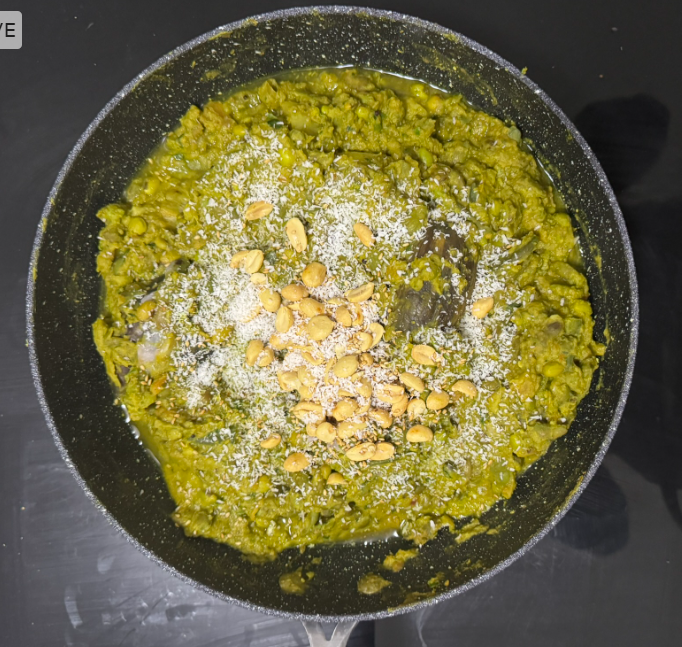Undhiyu is a hearty stew that uses tons of green and root veggies and plenty of warming spices
Winters mean warm, hearty soups and stews, cozy home-cooked meals, and movie nights with the family. While UK winters may be milder than in many places, the short, cloudy days still call for something vibrant, green, and comforting; like the Unidhiyu, an Indian pesto stew. And for a country that loves curry, what could be better than this classic Indian comfort dish?
What is Undhiyu?
Undhiyu is a seasonal specialty from Gujarat, traditionally enjoyed during Uttarayan, the kite-flying festival, on January 14th. Like all festive foods, the original recipe is indulgent, but I’ve added my usual healthy twists to create a lighter, nutrient-packed version. Packed with antioxidants from ingredients like fresh turmeric, green garlic, and a variety of colorful vegetables, this dish is as good for your health as it is for your taste buds.
Pro tip: Don’t be intimidated by the number of ingredients in the undhiyu! This dish comes together in an hour, and most components can be prepped ahead of time.
Since some ingredients might be unfamiliar, here’s a quick shopping guide. If you’re outside the UK, an Indian grocery store should have everything you need, while most supermarkets carry great substitutes.

Indian Ingredients & Substitutes:
- Fresh turmeric roots – Available in Indian stores, best in winter. A few grocery stores like Waitrose & Partners do sell fresh turmeric. Substitute with turmeric powder or paste.
- Surti papdi & Tuver beans (pigeon peas) – Found frozen in Indian stores and on Amazon. Surti papdi and tuver beans add a unique flavor, but you can skip them if needed. Frozen tuver beans is also often available in the full-size Asda stores.
- Hyacinth beans (Lablab beans or broad beans) – Available fresh or frozen in Asian groceries. Lablab beans is also available online or in large Waitrose stores.
- Grated coconut – Found in Asian groceries. Substitute with desiccated coconut from the baking aisle in all major supermarkets.
- Purple yam (Ratalu) – Available in select Indian stores and as ube in Asian (Philippines section) stores. You can substitute this with purple sweet potatoes but there is a difference in taste.
- Fresh green garlic – Found in Indian stores and British farmers’ markets in summer. Substitute with regular garlic.
- Small aubergines (eggplant/brinjal) – Available in Asian groceries and some British farmers’ markets. Most Indian grocery stores will surely carry this. You want to buy the Indian aubergines that are light purple in colour with white lines on them (image of the aubergines here).
Other Ingredients:
Fresh ginger, green chillies (rocket chillies from Tesco work best – you can also substitute this with the El Yucateco Salsa Picante), coriander, roasted peanuts, sesame seeds (or tahini), baby potatoes, and sweet potatoes.
Now that we have the ingredients out of the way, let’s dive into the recipe!
Undhiyu Recipe
For the masala (Indian pesto component)
- Combine all the ingredients above into a food processor. Start blitzing, adding sesame oil in batches as you blitz. Grind to a paste.
Preparing the vegetables
- Make crosses at the bottom of the aubergines and stuff it with the pesto masala. Be careful so as to not break the aubergines.
- Bake the potatoes for 4 mins and 30 seconds at the highest temperature setting. Once baked, make crosses on the potato and stuff it with the pesto.
- Let the sweet potato and purple sweet potatoes / ratalu or ube boil in water for 6-8 minutes (or until fork tender). Ensure that you retain the structure of the vegetables so that they have a charater and a crunch in the prepared stew.
- Drain the water and retain it. Cool the boiled vegetables under cold water for a minute to retain their structure.
Putting the undhiyu (stew) together
- Heat 1 tbsp of a neutral oil (or sesame oil) in a large skillet. I love using sesame oil for this recipe. Sesame oil adds a lovely Gujarati flavour and rounds up the entire experience. I buy the Idhayam sesame oil that goes perfectly a lot of Indian dishes (bonus tip: use it for your dosa and you will have the authentic South Indian restaurant experience). Add 2 tsp coriander powder and 2 tsp cumin powder.
- Add 30% of the water retained from the boiled vegetables and let it come to boil. Add your prepared Surti papdi, tuver beans and lablab beans.
- Now add 30% of the pesto mixute and mix well.
- Create some cavities and add the stuffed aubergines. Cover and cook on a medium flame for 15 mins or till the aubergines are completely cooked on all sides. Periodically check and keep turning the aubergines.
- Now add the prepared sweet potatoes, purple potatoes / ratalu or ube and the stuffed poatoes.
- Add the balance 70% masala, some salt, the sugar and let it all simmer and come together.
- Splash some of the retained water if the undhiyu thickens up too much for your liking. While undhiyu is ideally dry, a slightly liquid consistency is perfect for mopping up with some poori or bread.
- Once it all comes together, the undhiyu is ready.
Garnishing & Serving
- Garnish with coriander leaves, some roasted peanuts and 1-2 spoons of dessicated coconut.
- You can also squeeze some lemon if you fancy.
- Serve with fresh pooris, warm roti or any bread of your choice. The undhiyu also goes very well with some toasted sourdough.
Undhiyu: The hearty Indian pesto stew
Cuisine: IndianDifficulty: Intermediate4
servings45
minutes30
minutes350
kcalA vibrant, nutrient-packed Indian stew with a rich green masala, combining bold flavors and wholesome ingredients.
Ingredients
- For the green masala (the pesto component):
2 inches of ginger, coarsely chopped
3 fresh turmeric roots, coarsely chopped (or 2 tsp turmeric paste)
2 green chillies (add more if you want it spicy)
1/2 cup dessicated or grated coconut
1 tsp tahini or 2 tsp roasted seasame seeds
1 bunch of fresh green garlic or 6-8 cloves of garlic
1 bunch coriander (both stalks and leaves can be used)
3 tbsp roasted peanuts (or 2 tbsp unsweetened peanut butter)
Salt, to taste
Sesame oil, to blend
- For the stew:
2 Ratalu, peeled and cut into large cubes (or 3 ube / purple sweet potato)
300 gms of Surti Papdi, strings removed and halved
150 gms of Tuver (only the beans)
200 gms of lablab beans, strings removed and halved
3 small aubergines
1 large sweet potato, peeled and cut into large cubes
5-6 baby potatoes, unpeeled and halved
1.5 tsp sugar
Salt, to taste
- For the garnish
Few coriander leaves
1-2 tsp roasted peanuts
Directions
- For the masala (Indian pesto component)
- Combine all the ingredients above into a food processor. Start blitzing, adding sesame oil in batches as you blitz. Grind to a paste.
- Preparing the vegetables
- Make crosses at the bottom of the aubergines and stuff it with the pesto masala. Be careful so as to not break the aubergines.
- Bake the potatoes for 4 mins and 30 seconds at the highest temperature setting. Once baked, make crosses on the potato and stuff it with the pesto.
- Let the sweet potato and purple sweet potatoes / ratalu or ube boil in water for 6-8 minutes (or until fork tender). Ensure that you retain the structure of the vegetables so that they have a charater and a crunch in the prepared stew.
- Drain the water and retain it. Cool the boiled vegetables under cold water for a minute to retain their structure.
- Putting the undhiyu (stew) together
- Heat 1 tbsp of a neutral oil (or sesame oil) in a large skillet. Add 2 tsp coriander powder and 2 tsp cumin powder.
- Add 30% of the water retained from the boiled vegetables and let it come to boil. Add your prepared Surti papdi, tuver beans and lablab beans.
- Now add 30% of the pesto mixute and mix well.
- Create some cavities and add the stuffed aubergines. Cover and cook on a medium flame for 15 mins or till the aubergines are completely cooked on all sides. Periodically check and keep turning the aubergines.
- Now add the prepared sweet potatoes, purple potatoes / ratalu or ube and the stuffed poatoes.
- Add the balance 70% masala, some salt, the sugar and let it all simmer and come together.
- Splash some of the retained water if the undhiyu thickens up too much for your liking. While undhiyu is ideally dry, a slightly liquid consistency is perfect for mopping up with some poori or bread.
- Once it all comes together, the undhiyu is ready.
- Garnishing and serving
- Garnish with coriander leaves, some roasted peanuts and 1-2 spoons of dessicated coconut.
- You can also squeeze some lemon if you fancy.
- Serve with fresh pooris, warm roti or any bread of your choice. The undhiyu also goes very well with some toasted sourdough.
Notes
- The green (pesto) masala can be used as a base to cook many vegetables. Saute it with crispy sweet potatoes, in a potato sabzi (vegetable side) or with mixed greens.
- The prepared undhiyu can be stored in the refrigerator for about a week. It is best not to freeze it in order to retain the textures. The green masala can be stored in an airtight container for up to 14 days in the refrigertor and for 2 months in the freezer.
- Serving Undhiyu with pooris is considered a meal fit for the kings. Complete the plate (thali) with some sweet jalebis and green (tuver) kachoris.
Love the undhiyu but want to start off with something more familiar? Try this Gujarati-inspired Baingan ka Bharta instead!
I understand making Undhiyu can feel like a trek, but if you’re an adventurous cook and decide to take on the challenge, I’d love to hear about your experience in the comments below! Also be sure to share your experiences if you put your own twist on the green masala or make any fun modifications.

[…] curries and herby dishes with a green base (eg. Thai green curry, a pesto pasta or this Undhiyu): I love using Green Habanero. My absolute favourite is the El Yucateco Salsa Picante as fresh […]